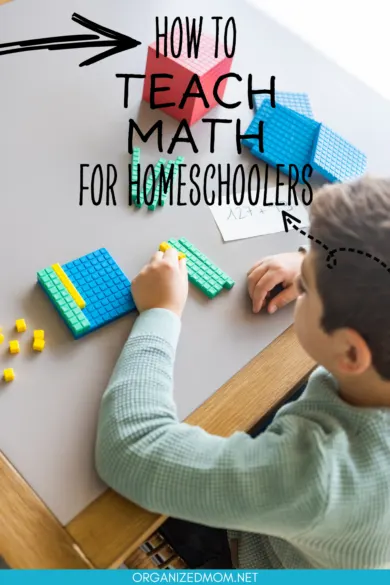STEM subjects are considered the toughest subjects to teach in a homeschool. This may be true but the wide application of mathematical concepts in the world makes this one of the most vital subjects to learn. You want to prepare your child to be a model citizen who can cope with the demands of society. They will have to do various mathematical operations and use deductive reasoning to survive optimally. This article highlights tips that will help you teach math for homeschoolers effectively as a beginner.
Understand your capacity to teach math for homeschool
Do you feel intimidated by the thought that you are responsible for imparting mathematical knowledge to your kids? Do you have self-doubt about your ability to deliver? Do not worry. It is okay to be nervous occasionally.
Once you understand your strengths and limitations, you will structure a better model for teaching mathematics to your kids. You will know what works for you, what does not, and how to take advantage of the available resources.
Conduct a placement test
As a new homeschooler, you may be confused about where to start. How do you know your child’s level of learning and mathematical coherence? A placement test will help you get a better perspective of where to start. Before you plan your lessons, you need to know your child is in which grade.
Building a solid foundation is critical when teaching mathematics. Here are several free online resources you can use when conducting placement tests;
- Online Algebra placement test by Seton
- Math Mammoth placement tests
- ACCUPLACER Practice Test
- Homeschool placement tests by Sonlight
- MobyMax Assessments
Start early and be patient
Start as early as possible. You do not want to rush your kids through mathematical concepts, especially if you are at the foundation stage. Let them learn at their own pace and be patient with them. There will be a lot of repetition and frustration at this stage. Be resilient. You will have many trials and errors at the foundation stage as you establish the learning pattern of your child.
Choose a solid homeschool curriculum
The curriculum you choose can enhance or worsen your homeschooling experience. There are hundreds of homeschooling curriculums at your disposal. How do you know which is the best curriculum for your child? Tap into your child’s interests and learning style to understand which curriculum would fit them best. Look for something that has a lot of activities, quizzes, and tests.
You can choose to buy a curriculum or use free online resources. Test various curriculums before settling on a particular one, especially if you want to spend money. Curriculums can be expensive. Before buying a curriculum check reviews to know whether it is what your family needs.
Use hands-on activities
Hands-on activities engage every sense and enhance memory retention in children. Manipulatives (blocks, cubes. Beans, etc.) help kids sort, order, recognize geometric shapes, understand patterns, and comprehend different mathematical operations. Hands-on activities also enhance their problem-solving skills.
Make learning math a fun activity
Kids get bored and distracted easily. If you try to hammer down a concept for hours they are bound to get distracted. Introduce the element of fun to keep the learning process exciting. Using hands-on activities is one way of bringing fun into a math class. Demonstrations, games, and other visual activities will help your child understand mathematical concepts easily.
Take breaks
The beauty of homeschooling is that you create your schedule. Unlike in a public school system, you can take as many breaks as you need when homeschooling. When teaching math in a homeschooling class, give your child as many breaks as they need to keep their mind fresh. Do something unrelated to math during these breaks so that when they go back to class their brains will be relaxed and ready for more lessons.
If possible, break down the lessons into short clusters with numerous short breaks in between. Handle a single concept in each of these lessons and let the kid relax for a few minutes to let whatever you taught them sink in. Teach at your kid’s pace. Do not rush through concepts even if you feel you may be falling behind the syllabus.
The whole point of homeschooling is to give your child the best education possible. This involves helping them understand how things work as opposed to making them cram concepts to pass their exams. Ensure they have understood the concept well before moving on to others.
Take it a step at a time
To ease the stress of teaching math for homeschoolers and yourself, take everything in a stride. Schedule your lessons in such a way that enables you to take care of a single concept before moving on to other more complex ones.
For instance, you can schedule one week to learn about subtraction. Teach your child how to conduct single-digit subtraction exercises. Once they grasp the basics advance them to two-digit problems and so on. When they have mastered the subtraction concept introduce another (such as multiplication) the following week.
Utilize free online resources
There are numerous (and free) online resources tailored for every grade and category. These resources save you money and give you plenty of tools to use in homeschooling math. We are talking about workbooks, tutorials, worksheets, and mobile applications.
Some of the popular free online resources that can help you teach math include the Khan Academy and YouTube Kids. The resources contain unlimited hacks and tips to help you teach math to your child irrespective of the grade.
Do not aim for perfection
Trying to be perfect when homeschooling is futile. There are days you will feel like giving up. We have been there as well. Instead of aiming for perfection when teaching math, try delivering your best every time. Do not worry whether your local math teacher would approve of your teaching method.
If you feel tired in the middle of a lesson, take a break and reschedule. Do not force things as this might lead to homeschooling burnout. Record how long you spent on that lesson and compensate for the time lost in another session.
Repetition is the key to teaching math
Your child may not remember anything you taught them yesterday. That is where repetition works well. Before you start a new lesson revisit the previous one and highlight the main points. Repetition will help some of these concepts to stick in your child’s brain. It is a slow but effective process. Summarize every lesson with assignments they should do on their own.
Encourage discussion
Always encourage your children to ask questions and give feedback on whatever you cover in class. If they have not understood a concept well, encourage them to speak out. You may also be surprised that they can come up with different ways of solving particular problems.
When you give assignments and tests let the kids explain the steps they took to solve certain problems. This engagement will build up their confidence and help them understand other concepts in the future better. Give feedback after they explain their reasoning and point out areas they can improve on.
Celebrate and reward progress
Once the kids have understood a tough concept or passed a tough test celebrate this achievement. Discuss with them the reward modality and let them participate actively in the planning process. This will motivate the kids and make them eager to learn new concepts in the future.
Encourage teamwork
If you are homeschooling more than one kid, encourage them to work together on certain concepts (irrespective of the grade level). The younger kids can learn from the older kids. Encourage them to be attentive to details, be keen listeners, be respectful to one another, and give each other space to share their opinions.
Use positive reinforcement
There are days when nothing seems to go well. No matter how you try your child doesn’t seem to understand a concept. It can be frustrating. However, instead of yelling or scolding them, use positive reinforcement to let them know that it is okay they can make mistakes and encourage them not to give up. Take breaks if necessary but do not let your frustration drain your energy when homeschooling math.
Conclusion
Teaching math for homeschoolers can be challenging but not impossible. When you use the strategies outlined here you may enjoy teaching this subject! Kids love having fun and when you introduce the element of fun in teaching math, you are already halfway there. You will need a ton of patience as some concepts will challenge you. Understand your child’s learning ability and structure your teaching around these abilities. Encourage your child to be an active participant in the learning process and reward them when they master a difficult concept. When things get wrong, use positive reinforcement to rectify them and keep your eyes on the goal. There is no particular correct way of impacting knowledge in your child while homeschooling. Adopt what works for you, learn from other homeschoolers and you will enjoy teaching math within no time.




